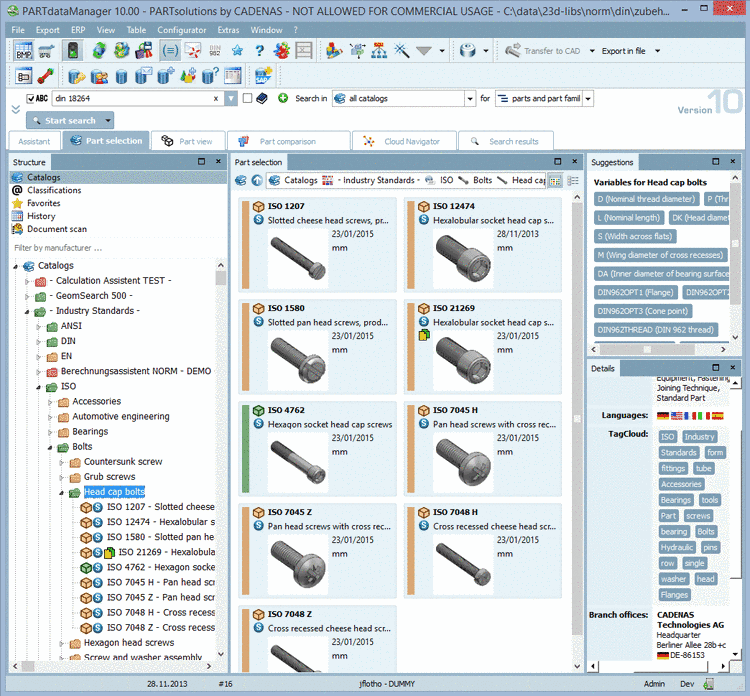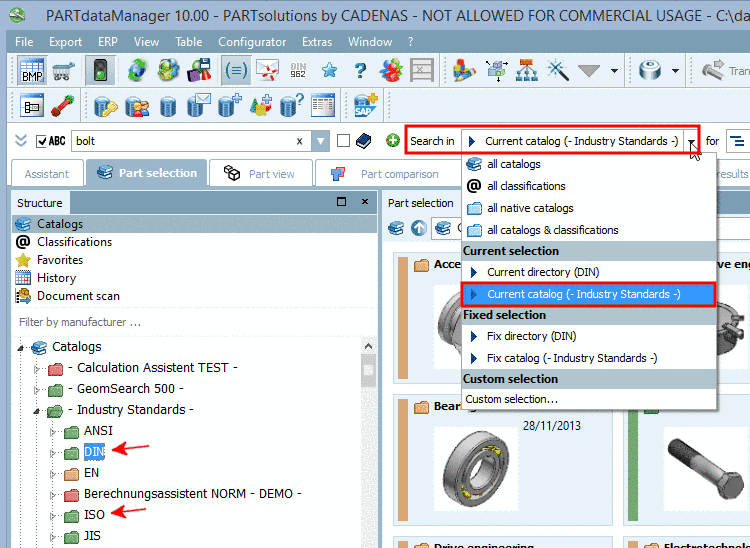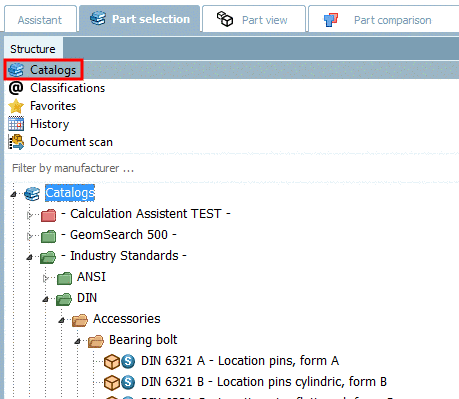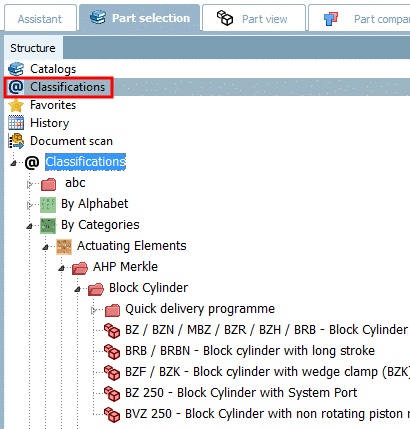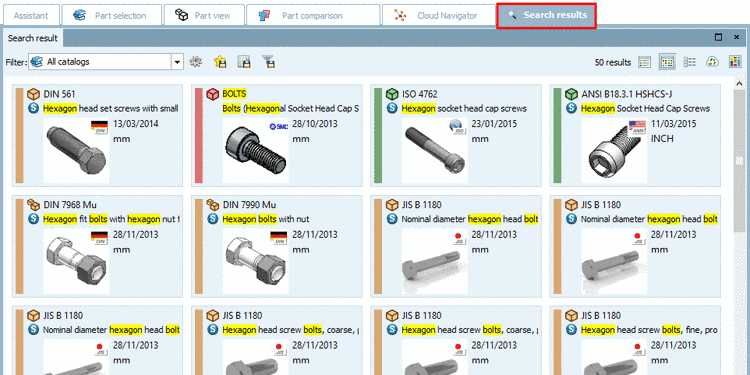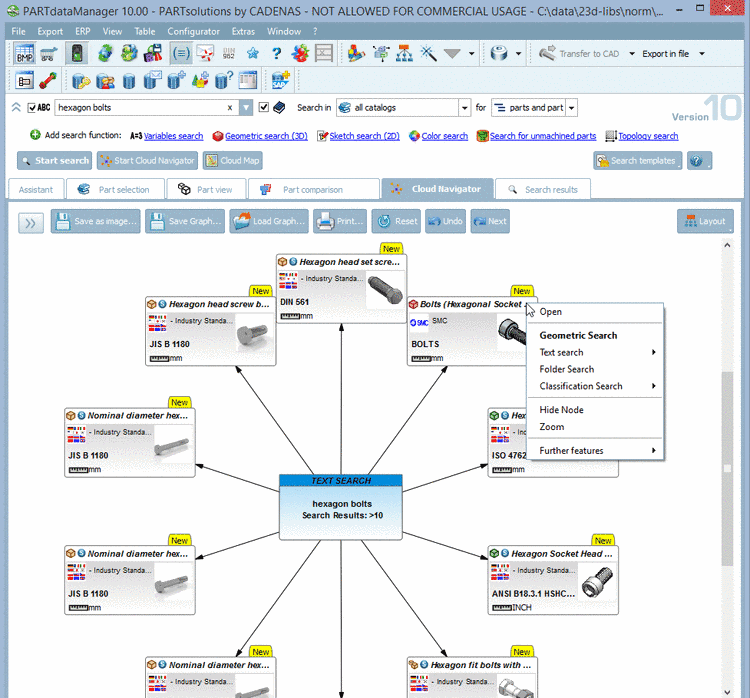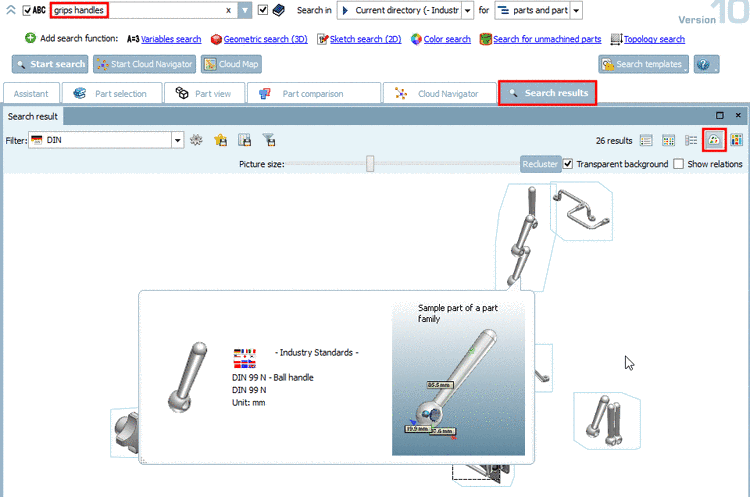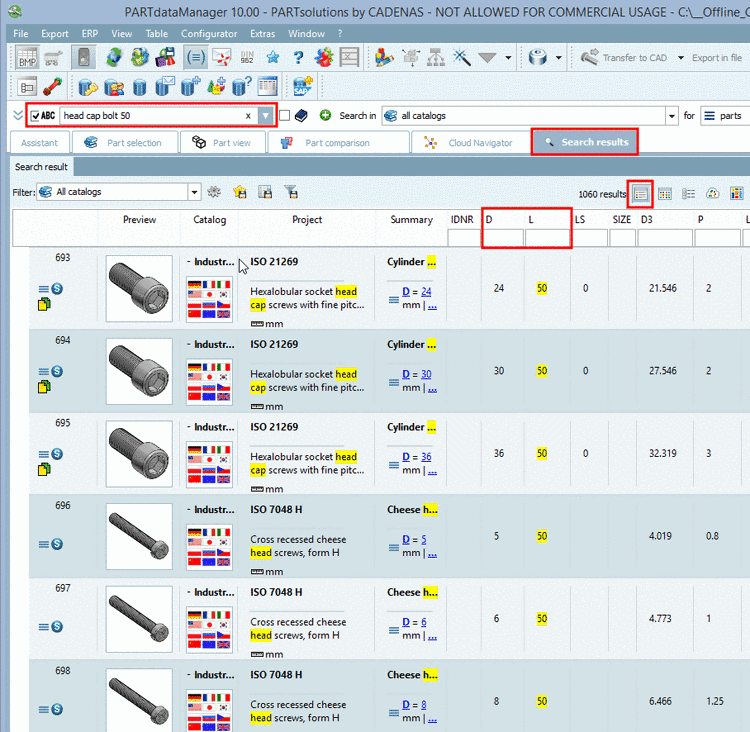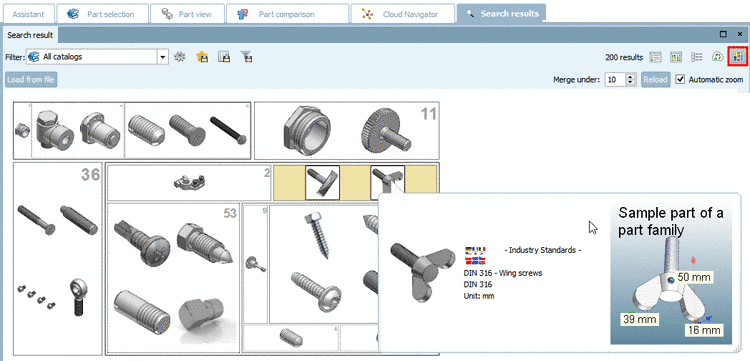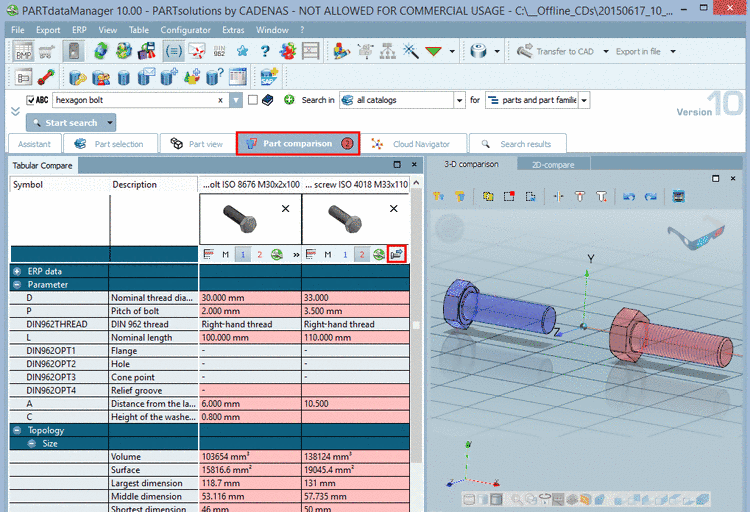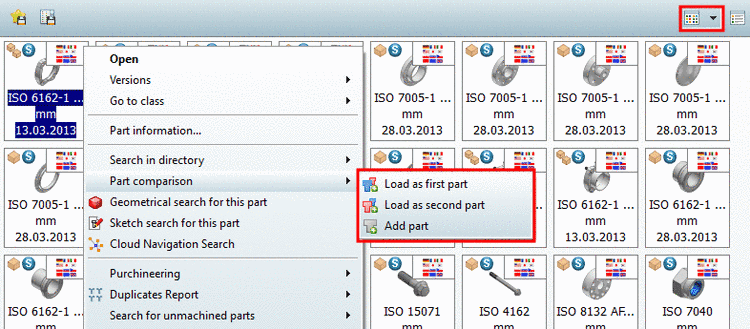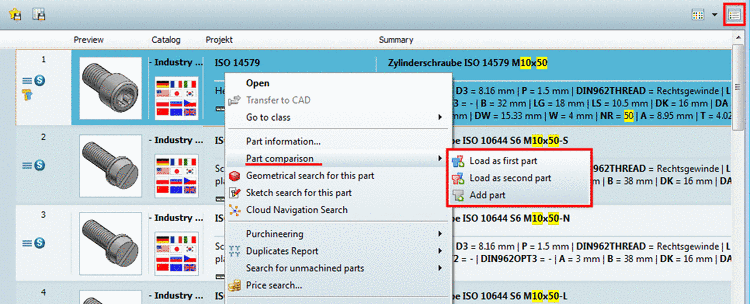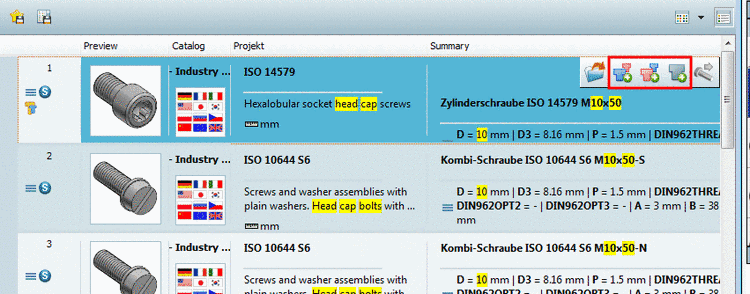Manual
Login
Our 3D CAD supplier models have been moved to 3Dfindit.com, the new visual search engine for 3D CAD, CAE & BIM models.
You can log in there with your existing account of this site.
The content remains free of charge.

Top Links
Manual
Concerning part search different questions matter:
Do you want the results encompass a wide range of adequate parts or special ones?
Do you want to search a certain catalog or directory?
Are concrete parameters like diameter or length for example already determining or do you only want to search adequate part families in a first step?
Do you want to substitute a certain part?
Is a reference part available?
Do you know the exact designation?
The search options take account of the various requirements:
In the following you can find short explanations on the single setting options or functions. Each point contains links to detailed information:
-
Search in...: In the opened list field you can find different options. At some options a specific directory is displayed in brackets. This is according to the one selected in the directory tree.
Define the area to be searched in the list field under Search in....
Search all...: Optimal gathering of all possible parts, but less overview.
Specified search area: The desired hits do not have to be limited later.
-
-
Current directory (<Name of selected directory>)
When selecting Current directory the value in Search in changes analogously to the directory change in the index tree.
That means, the search is always processed on the selected directory.
-
Current catalog (<Catalog name of selected directory>)
When selecting Current catalog the value under Search in remains the same, as long as the index tree selection is inside the set catalog. Not until the catalog is changed while browsing, under Search in, the new catalog is set.
That means, the search always refers to the catalog, where you are in.
In this exemplary figure the catalog displayed under "Search in" would not be changed when changing from DIN to ISO in the index tree.
-
-
When selecting Fix directory or Fix catalog, the displayed setting under Search in Fix directory Fix catalog remains unchanged when browsing in the index tree. The functionality of both options is identical. By switching from the "Fix directory" option to the "Fix catalog" option you can save the switching in the index tree itself.
Detailed information is found under Section 3.1.1.6.2, “Determine catalog/classification/directory to be searched”.
-
Search for: Part families or single parts?
-
Less overview unless that the specification already happened by the method itself.
For example by declaration of variables at the full-text search:
hexagon bolt D>=10 D<=16 L=50
This mode is especially important for searching own part catalogs, because often heterogeneous parts with quite different look are collected in a classification project.
Detailed information on this can be found under Section 3.1.1.6.3, “ Search for Parts | Part families and Parts ”.
-
-
Which search method(s) shall be used?
Basically there are two options: A manual search of the directory structures or the use of automated search methods.
-
Manual search of the directory structures:
For example, select the subitem Catalogs or Classifications and search the respective directory structure for the desired part.
At the project icons (e.g.
 (part) or
(part) or  (assembly)[28] , you can recognize the project
level.
(assembly)[28] , you can recognize the project
level.As soon as you have selected a part with a project icon (e.g.
 (part) or
(part) or  (assembly) via double-click, the user
interface switches to the Part view. You can find detailed information on the Part view under Section 3.1.1.7, “
Part view
”.
(assembly) via double-click, the user
interface switches to the Part view. You can find detailed information on the Part view under Section 3.1.1.7, “
Part view
”.You can find detailed information on the single tabbed pages under Section 3.1.1.6.4.9, “ Part selection via index tree ”.
-
Automated search of the directory structures:
The Full-text search is opened and activated at program start by default (checkbox).
The other search methods are hidden (default). You can open or hide the area of the enhanced search methods by clicking on the arrow icon

 .
.Even in hidden state you can use the enhanced search methods. Simply click on the green Plus button
 .
.-> The respective dialog with the respective setting options opens.
Used methods are shown with checkbox and icon. See following figure.
If the area of enhanced search methods is open then you can see the respective setting parameters in addition.
With click on
 methods can be removed from the list.
methods can be removed from the list.Via checkbox
 methods can be activated or deactivated for a
certain run.
methods can be activated or deactivated for a
certain run.You can find detailed information on the single search methods and additional options under Section 3.1.1.6.4, “ Search methods ”.
-
When the Search for synonym
 is activated before the actual search the
synonym database is queried using the entered keyword and then the
search is performed with all found terms. A tooltip appears with the
substituted synonyms (search terms).
is activated before the actual search the
synonym database is queried using the entered keyword and then the
search is performed with all found terms. A tooltip appears with the
substituted synonyms (search terms).You can find more information on this under Section 3.1.1.6.4.2.4, “ Full-text search supplemented with synonyms ”.
-
Search settings: save/load template
Especially with complex settings you can save time, when using Search templates:
On this see Section 3.1.1.6.5, “ Search settings: Save as template / load”.
-
-
Start Standard search or Cloud Navigator or Cloud Map?
The quality of search results is identic independent of the chosen mode.
-
When you click on
 ,
the search results are listed below on the Search results tabbed page.
,
the search results are listed below on the Search results tabbed page.You can find detailed information on this under Section 3.1.1.6.7, “ Search results ”.
-
When you click on
 , the search results are listed below on the
Cloud Navigator tabbed page.
, the search results are listed below on the
Cloud Navigator tabbed page.You can find detailed information on this under Section 3.1.1.6.11, “ Cloud Navigator ”.
The Cloud Navigator search is an alternative mode.
The determination of the search method, the search result output and the determination of a search method once again takes place within a graphic depiction (the cloud).
-
When clicking on
 the search results are displayed below on the tabbed page Search results with mode Cloud Map
the search results are displayed below on the tabbed page Search results with mode Cloud Map  .
.
-
-
The search results are displayed below on the Search results tabbed page in different modes:
-
The Details mode shows the Table variables. Namely not only for common variables but basically which may lead to large tables (depending on search settings).
Above each column you can find an input field for filtering. Even if not all hits are displayed on the search results tabbed page the filter affects all hits anyhow and adjusts the display of the table variables dynamically. You can filter some variables one after another, already set values will remain.
-
The Symbols mode shows large preview images and the most important information such as standard number and name.
-
The Table mode shows the Table variables as well and widely corresponds to the Details mode. However, smaller preview images are displayed here and the column Summary is omitted so that you can see more columns at a glance.
-
Dependent on the setting parts
 or parts and part families
or parts and part families  .(compare above) the access on single
parts is different. Whether the superordinate project (part or assembly)
or a concrete characteristic is displayed you can recognize at the
respective icon:
.(compare above) the access on single
parts is different. Whether the superordinate project (part or assembly)
or a concrete characteristic is displayed you can recognize at the
respective icon:In the context menu of a part family or a single part you can find various commands. In the Details mode buttons are displayed in addition.
Via
 Open for example
you can switch to the Part view. You can
find detailed information on the part view under Section 3.1.1.7, “
Part view
”.
Open for example
you can switch to the Part view. You can
find detailed information on the part view under Section 3.1.1.7, “
Part view
”.Via
 for example you can open the Part comparison or load a part into the
part comparison. You can find detailed information on Part comparison under Section 3.1.1.6.10, “
Part comparison
”.
for example you can open the Part comparison or load a part into the
part comparison. You can find detailed information on Part comparison under Section 3.1.1.6.10, “
Part comparison
”.-
There are no results for your request:
Check which terms are mentioned in the Part information and alternatively use these.
-
See Section 3.1.1.6.7.6, “ Suggested corrections for typing errors e.g. - Did you mean ”.
-
See Section 3.1.1.6.7.7, “ "Related results" - Specify / broaden search ”.
-
More precise (AND) / Broaden search
If you get insufficient search results please regard the notes under Section 3.1.1.6.7.7, “ "Related results" - Specify / broaden search ”.
-
If there are more than 50 search results[29] below at the page end, the button appears. Normally you will find the desired hits under the first. If you still want to see more results, then successively click on or .
-
On this see under Section 3.3.11, “ "Search" tabbed page ”.
-
Save search results: in favorites / in file
The search delivered parts which you often use?
Then select them all or single lines (selection via Ctrl key) in the search result list and save them under your favorites.
Perhaps you want to pass along the search results and/or process in an external program?
Then save the search results (with the desired information from the table) in a text file.
You can find the commands in form of two icons top left over the search results.
 Save search results in favorites: See Section 3.1.1.6.7.5, “
Save search results: in favorites / in file”.
Save search results in favorites: See Section 3.1.1.6.7.5, “
Save search results: in favorites / in file”. Save search results in a file: See Section 3.1.1.6.7.5, “
Save search results: in favorites / in file”.
Save search results in a file: See Section 3.1.1.6.7.5, “
Save search results: in favorites / in file”.
-
Have a look on detailed catalog and project data. See Section 3.1.1.6.8.1, “Docking window "Details" ”.
Have a look on the Part information. You can find the command in the context menu of each part.
-
-
You can add parts directly from the search results to the part comparison. (Via Drag & Drop, buttons or context menu command)
-
There are several ways to open the Part comparison window/docking:
The part comparison can be used as docking or single window. In order to move the window click on the title bar with pressed mouse button.
The compare can be performed on a textual base with various parameters (table variables, classification attributes, topological data from geometry).
Two parts a time can be loaded into the 2D/3D comparison. Coloring in the sectional view marks the differences, measuring grids can be displayed and show the dimensioning, and much more.
You can find detailed information on this under Section 3.1.1.6.10, “ Part comparison ”.
[28] These are the most common icons. All other you can find under Section 3.1.1.12, “Legend: Used icons on catalog, directory, project level and part view ”.
[29] If you want to change the presettings, then please click on the "Search settings" button and select the "General" tabbed page.

